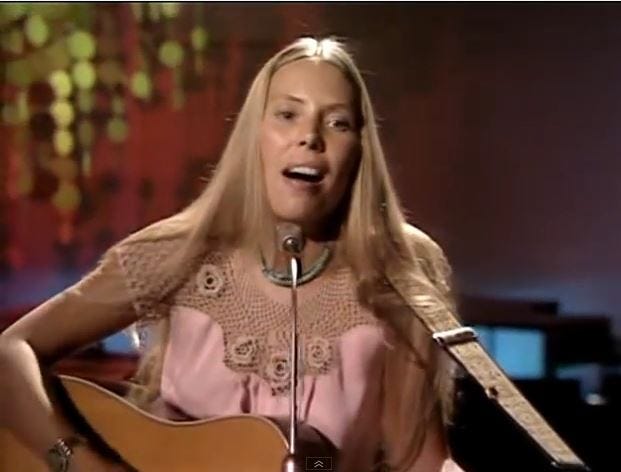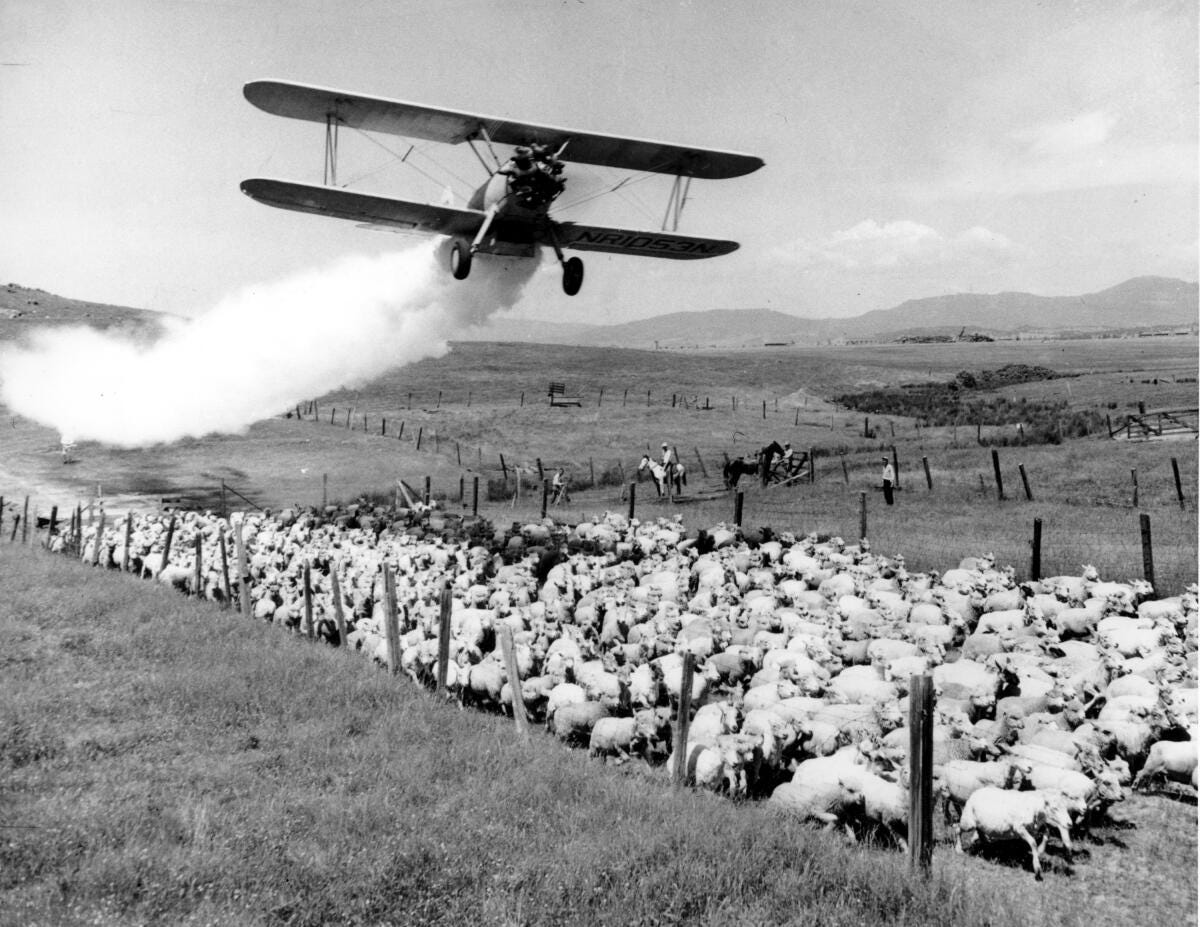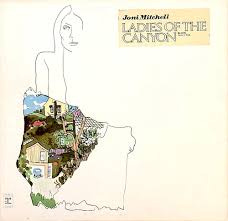"Big Yellow Taxi" - Joni Mitchell (1970)
My favorite protest songs from the 60s and early 70s
This is the eighth in a series about my favorite protest songs from the sixties and early seventies.
I’ve been trying, from among my list of favorites, to present a variety in terms of artist, style, and message. So far we’ve heard:
“Blowin’ in the Wind” by Bob Dylan (1963)
“Masters of War” by Judy Collins (1963)
“Eve of Destruction” by Barry McGuire (1965)
“For What It’s Worth (Stop, Hey What’s That Sound)” by Buffalo Springfield (1966)
“Gimme Shelter” by the Rolling Stones (1969)
“Sweet Cherry Wine” by Tommy James & the Shondells (1969)
“Give Peace a Chance” by the Plastic Ono Band (1969)
I’ve also sent you Jackie R’s post sharing a song that makes fun of protest songs, as well as NickS’s post asking “What makes a good protest song?” in which he gives his own list of favorites — and where the Comments section has become an ongoing discussion about this topic, which you are welcome to join.
Today we have a protest song about an issue not covered yet, and one that might surprise you as a bona fide protest song.
Protest song of the day
Joni Mitchell wrote the song “Big Yellow Taxi” in a place synonymous with stunning natural beauty and jaw-dropping tropical sunsets, but what she found when she got there had devastated these expectations:
“I’d gone to the Hawaiian islands for the first time, arrived in the middle of the night. I went to the hotel. It was in Oahu [below]. It was a skyscraper. Woke up in the morning, threw back the curtains, and in the distance were green, green mountains and white flying birds. And I looked down, and as far as the eye could see was a parking lot.”

As she told journalist Robert Hilburn in a 1996 interview, “It broke my heart […] this blight on paradise. That's when I sat down and wrote the song.”
Joni was not given to making political statements. As she admitted, “A lot of hippie politics were nonsense to me.”
But she also saw herself as “kind of a barometer of the times that I walk through” and “a confronter by nature.”
As an artist, she believed that she had “always had a different perspective — an artist is a sideliner, not a joiner; they must have a certain clarity and depth, which is burdensome and really inconvenient for fun.”
True that. Looking out that window, most of us would no doubt have muttered “Oh, well,” if we noticed the oversized parking lot at all, rushed to don our swimsuits, and bustled outside to jump in the pool or cavort in the ocean.
Joni, on the other hand, was sitting in the hotel room turning her dismay at the state of Waikiki into a song.
She was only there for two days, accompanied by her paramour at that time, musician Graham Nash (The Hollies; Crosby, Stills, Nash & Young), who must have left her to get on with her work.
As he observed, “Watching her write was a most interesting process. It’s almost like she channels. She was gone for hours. I mean, she was physically right there, but she wasn’t there. She was gone. I’d say things to her and she wasn’t even listening. She was gone. And it was a great thing to see. A great thing to see somebody taken away by vision.”
That vision, whether listeners have realized it or not, has an insistent environmental theme running through it:
“I’ve always been very sensitive to the natural world and ashamed of my species for its treatment of it. That’s my cross to bear. And that’s probably the main thrust of my work and the main pain that I suffer as a human being… I suffer because of the stupidity of our management of this planet.”
Joni explained the overall concept of the song as “Which will win, nature or the concrete jungle? Are we going to pave everything over? Are we going to leave parks? Or are we going to fall one way or another? And will then the jungle take it all back?”
The song is not just about paving over paradise with concrete parking lots, however. Joni brings up two other environmental issues. One was her shock at discovering that people were actually paying money to see trees inside the Foster Botanical Garden (below), what she referred to in the song as a “tree museum,” rather than nature being a free, accessible, and valued part of the urban environment. (See the lyrics on Joni’s website.)
The other was the widespread use of DDT, an insecticide and agricultural pesticide toxic to all living creatures, with an especially pernicious effect on the reproductive capacity and populations of birds, but also linked to premature births and low birth weight in humans.
Joni was right to draw attention to this issue, as DDT persists to this day in soils and rivers despite being banned in the U.S. in 1972 and in Europe in 1978, and continues to be manufactured and used in Asia, Africa, and South America.
It might seem from this fact that she was naive about the power of the artist in effecting change, but she’s actually quite the realist. “The sixties were a very idealistic time for youth, very hopeful. We did believe that we could change the world. We found that we couldn’t change it very much at all.”
About the impact of “Big Yellow Taxi” in particular, she became aware that it did have some ‘concrete’ impact. (Sorry, couldn’t resist!)
“When it first came out, it was a regional hit in Hawaii because people there realised their paradise was being chewed up. It took 20 years for that song to sink in to people most other places. That is a powerful little song because there have been cases in a couple of cities of parking lots being torn up and turned into parks because of it.”
She was also aware that “wherever a tree was being cut down, someone trotted [the song] out. I suppose it did a little bit of good.”
A little bit of good is a dramatic understatement, as the song has become not just a theme song for so-called tree huggers and saviors, but also a standard for many environmental and ecological causes and an anthem for the environmental movement in general.
My take on why this is the case, considering the fact that there have been a number of other rock and pop songs with environmental themes, is that it is a song not against but for something. It is an inspiration and a call to action, with its rousing uptempo and evocative lyrics that call up images not of destruction and doom, but of a paradise that we will lose if we don’t wise up and do something to preserve it.
The song also has personal relevance for everyone when she segues at the end from the big picture to everyday life, bemoaning the slam of the screen door and a big yellow taxi taking away her “old man.” Another loss of paradise, but you don’t ‘get’ what you’ve actually lost until it’s removed from your life, temporarily or for good.
Some interpret this final verse as being about the battles of the anti-war movement with governmental authorities and the harassment of ‘longhairs’ by the local police, with the “big yellow taxi” being the standard yellow patrol car at that time of the Metro Toronto Police (where Joni had lived early in her career). I have been unable to find confirmation of this interpretation by Joni.
The album which features the song, Ladies of the Canyon, was released in April 1970, going to #27 on the Billboard 200 in the U.S. and to #8 in the UK, and eventually being certified platinum.
Note that that’s Joni’s artwork on the cover. She has done the artwork for all of her albums (and paints large oil canvasses as well).
“Big Yellow Taxi” was the one song from the album released as a single, rising to #67 on the Billboard Hot 100 that year, but even higher to #24 when a live version with jazz fusion band L.A. Express was released on her Miles of Aisles album in 1974. It is one of only four Top 40 hits that Joni has had over the course of her career.
She has also released several newer versions, notably a maxi-single presenting remixes in different styles timed to coincide with the song being featured on the wildly popular TV sitcom Friends, and a new arrangement on her album Shine in 2007.
The song has remained remarkably popular not just with the environmental movement but with listeners in general. In Canada (her home country), it continues to get significant airplay and was voted #9 on the Canadian Broadcasting Corporation’s list of the Top 50 Tracks in Canadian pop music history.
It has been covered by 589 other artists in the intervening 54 years, with Amy Grant taking her cover to #18 on the Adult Contemporary chart in 1995 and Counting Crows featuring Vanessa Carlton hitting the Top 10 of various charts and achieving a gold record with their version in 2002.
Now, let’s hear the song from Joni herself. I think you’ll love this really swinging live version with L.A. Express that appeared on Miles of Aisles and went Top 40. You can also listen to the original recorded version from 1970 here. Enjoy!
Album credits
Ladies of the Canyon
Songwriter - Joni Mitchell
Producer - Joni Mitchell
Musicians:
Joni Mitchell - vocals, guitars, keyboards
Teresa Adams – cello
Paul Horn – clarinet, flute
Jim Horn – baritone saxophone
Milt Holland – percussion
Production personnel:
Henry Lewy – engineer, production advice
Don Bagley – cello arrangement
Miles of Aisles
Joni Mitchell – vocals, guitar, piano, dulcimer, cover photograph and graphics
The L.A. Express
Tom Scott – woodwind instruments, harmonica
Robben Ford – electric guitar
Larry Nash – piano
Max Bennett – bass
John Guerin – drums, percussion
Technical
Henry Lewy – sound engineer, mixing
Sources:
Big Yellow Taxi Lyrics and Footnotes. https://jonimitchell.com/music/song.cfm?id=13.
Girls Like Us: Carole King, Joni Mitchell, Carly Simon — and the Journey of a Generation. Sheila Weller (2008).
Hilburn, Robert (December 8, 1996). "Both Sides, Later". Los Angeles Times. Los Angeles, CA. ISSN 0458-3035. OCLC 3638237. Retrieved from the “Big Yellow Taxi” Wikipedia entry on September 10, 2024.
https://www.facebook.com/watch/?v=243315278154550. Original source is the documentary When Hippies Ruled the World (2002).
Lady Blue. A documentary by Julia Kuperberg and Clara Kuperberg.
RollingStoneRaves: What Your Rock & Roll Favorites Favor. Rolling Stone Press (1999).
The Rolling Stone Interviews 1967 - 1980: Talking with the Legends of Rock & Roll. (1981).










Sadly the original recording was ruined for me by the incongruity of the laugh at the very end. The live version recorded with Tom Scott and the LA Express remains my favourite. The original reached number 11 in the singles chart here in the UK and was very much seen as a protest song from the beginning although I recall being unsure what a “parking lot” was (we call them car parks)!
I wish Joni was from my hometown (Totonto). She was actually born in Fort Macleod, Alberta.